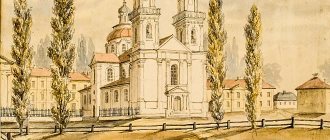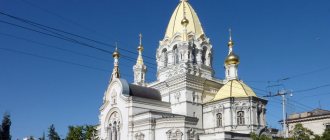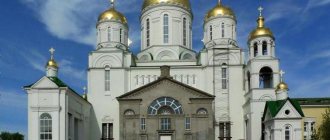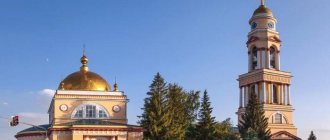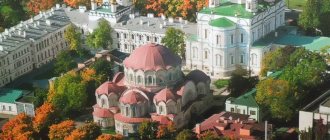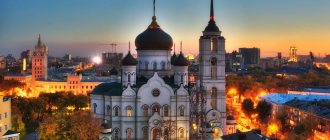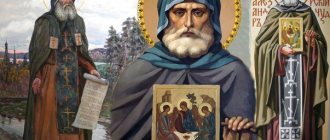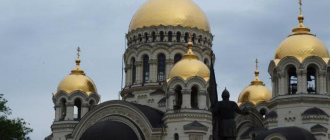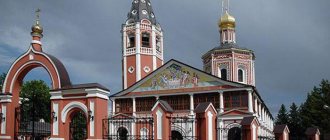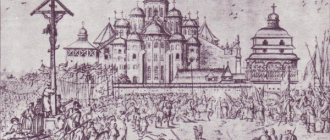"Save me, God!".
Thank you for visiting our website, before you start studying the information, please subscribe to our Orthodox community on Instagram, Lord, Save and Preserve † - https://www.instagram.com/spasi.gospodi/. The community has more than 60,000 subscribers. There are many of us like-minded people and we are growing quickly, we post prayers, sayings of saints, prayer requests, and timely post useful information about holidays and Orthodox events... Subscribe. Guardian Angel to you!
The Cathedral of the Blessed Prince Alexander Nevsky is distinguished by eighteen white columns against the backdrop of modern architecture. The building itself has a proportionate structure and a clear three-dimensional appearance. It fits into the architectural urban planning ensemble of Izhevsk.
St. Michael's Cathedral
The cathedral is located at the highest point of Izhevsk and is one of the most beautiful religious buildings. Once upon a time, the very first city cemetery, founded in 1765, was located on this site.
A little later, a small wooden Holy Trinity Chapel was erected on the territory of the churchyard, which was rebuilt into a church in 1874. In 1810, there was a fire and the cemetery church burned down completely.
In 1855, a large chapel was built, consecrated in the name of Archangel Michael. In 1876, fundraising began in Izhevsk for the construction of a new large temple. In 1896, construction of a new St. Michael’s Church began on the territory of the city necropolis.
By 1907, the main construction was completed. The majestic building could be seen from a distance of 20 km, and the ringing of bells spread throughout the surrounding area. Further improvement of the shrine was stopped due to the revolutionary unrest. The ceremonial consecration of the temple took place in the fall of 1915. And in 1929 the temple was closed by the Bolsheviks.
By 1937, nothing remained of the building of St. Michael's Cathedral in Izhevsk. The walls of the temple were dismantled, and bricks from the masonry were used in the construction of city buildings. The bells and crosses were removed and sent for melting down.
According to the authorities' plans, a theater was to be built on this site, but there was not enough money for this. As a result, a park was laid out here and a fountain was installed.
Shrines
Over the decades after the church was returned to the believers of Izhevsk, its collection was replenished with many shrines.
- An exact list of the Pochaevskaya Icon of the Mother of God, located above the main gate of the central iconostasis. On the eve of the day of the Annunciation and the feast of the venerated image, it is removed from the iconostasis and the ritual of anointing with oil is performed.
Interior decoration of Alexander Nevsky Cathedral - The temple image of the Holy Blessed Prince Alexander Nevsky with a particle of relics was ordered for the 195th anniversary of the foundation of the cathedral.
- The icon “Washing the Feet by a Disciple” is one of the oldest temple shrines, located in one of the iconostases until the cathedral was closed. The image, in need of serious restoration, was returned to the parish in 1993. The shrine, restored at the expense of a benefactor, was consecrated in 2014.
- The icon “Head of St. John the Baptist” has a miraculous history of appearing in a holy place. Cut in half, it ended up in the church in the early 90s. The desecrated image was placed in a warehouse, and a few days later it was found miraculously completely restored.
- The Life-Giving Cross of the Lord is a unique shrine with more than a century-old history. It was made by Athonite monks for the 300th anniversary of the House of Romanov. In Jerusalem, where the cross was brought for consecration, a stone from Golgotha and a piece of the Life-giving Cross of the Lord were inserted into it. Due to the establishment of Soviet power in Russia, the relic remained in the Holy City until the 80s. XX century Metropolitan Nikolai of Udmurt and Izhevsk returned her to Izhevsk.
In addition to the listed valuables, the cathedral contains a reliquary with particles of the relics of many Orthodox saints.
Current state
The cathedral was rebuilt and restored between 2004 and 2007. Today it is a whole temple complex, which, in addition to St. Michael’s Cathedral, includes the Kazan Church, the Chapel of Peter and Fevronia, a cemetery, Jordan and a bypass gallery - a walkway. Lawns are laid out throughout the territory and bronze sculptures are installed.
The cathedral is made in the Russian-Byzantine style. Unlike other Izhevsk churches, it does not have a front facade and looks the same from any vantage point. Today, having overcome all difficulties, the cathedral delights the townspeople and guests of Izhevsk with its splendor.
Address: st. Karl Marx, no. 222.
Alexander Nevsky Cathedral
The model for its construction was the Cathedral of St. Andrew the First-Called in Kronstadt. The Nevsky Temple was erected under the leadership of the architect S. Dudin in 1823.
The majestic cathedral building is designed in the style of strict Russian classicism. The cube-shaped structure is covered with a round drum vault. The spreader is supported by four powerful supports with smoothed corners.
Initially, the cathedral was decorated in a restrained style, but in 1870 its interiors became more pompous. The craftsmen gilded the stucco moldings, architectural elements, domes and iconostasis.
Nevsky Temple was considered the main cathedral of Izhevsk for a long time. Several churches and chapels were assigned to it. Including St. Michael's Cathedral.
St. Alexander Nevsky Cathedral
Architect A.D. Zakharov with the participation of S.E. Dudin.
St. Alexander Nevsky Cathedral St. Michael's Cathedral Mosque
Built in 1816-23 based on the design of the surviving St. Andrew's Cathedral in Kronstadt (1817, architect A.D. Zakharov). The central boundary is consecrated in honor of St. Blessed Grand Prince Alexander Nevsky, right (south) aisle - in the name of St. Great Martyr Catherine (her day was celebrated for a long time as a general holiday in Izhevsk), the left (north) one is in honor of the Kazan Icon of the Mother of God, the lower “cave” church is in honor of St. martyrs Blasius and Modest.
In March 1922, the commission under the leadership. Member The All-Russian Central Executive Committee of I.A. Nagovitsin confiscated 5 poods from the cathedral. Silver, gold, precious stones. In March 1929, the cathedral was closed at the request of the Youth Union of Militant Atheists. In the summer, all 24 bells were removed from it. At the same time, the bell tower was destroyed and the cathedral was converted into a club.
In 1932, after a new reconstruction, the Colossus cinema opened here. In 1937 the dome was demolished.
The cathedral was returned to believers in 1990. In the last decade of the 20th century. The Cathedral of the Holy Blessed Prince ALEXANDER NEVSKY in Izhevsk turned out to be the focus of financial, spiritual and creative efforts not only of the clergy and parishioners of the entire diocese, but also of ordinary citizens, far from the Church, but gradually realizing the need to help it in the difficult task of reviving the main shrine of the cathedral city of Udmurtia. Miraculously transforming day by day, this building excited public attention with its rare, mysterious beauty. For this reason alone, it gradually began to be perceived as a symbol of the revival of the Izhevsk and Udmurt diocese itself.
Story
Temple in Mazunino. Initially it was planned to build it in Izhevsk. Project by architect A.D. Zakharov for Kronstadt (St. Andrew's Cathedral). 1806
The first project for Izhevsk, developed by S.E. Dudin based on Zakharov’s drawings. Incision. 1819
The cathedral in the 1900s. The religious, cultural and “astronomical” center of the village of Izhevsky Plant.
Column in memory of Grand Duke Mikhail Pavlovich in front of the main facade of the cathedral. 1856
Destruction of the bell tower. Summer 1929
The main iconostasis of the cathedral before its destruction in 1929.
Unveiling of the monument to I.D. Pastukhov at the former Alexander Nevsky Cathedral. May 1, 1933
Destruction of the main porch. Summer 1934
The Kolos cinema still has a dome. 1935
A monument of Russian classicism “smoothed” under socialist dullness in 1939.
Rebuilding in 1994
The need to build a cathedral in the center of Izhevsk was realized by the factory and spiritual authorities after the fire of 1810, which destroyed a significant part of the village's buildings along with the then main Church of Elijah the Prophet. The very next year, the factory architect S.E. Dudin, who was also elected ktitor (headman) of the mentioned church, completed the design of a monumental cathedral with three altars, three bell towers and a rectangular altar projection (which was one of the features of his architectural style of those years). The project of an outstanding architect, who graduated from the Academy of Arts with a large gold medal, and also trained in Italy, was regarded in St. Petersburg as “magnificent.” But the authorities still considered that the construction of a monumental building would require “considerable costs” and would be “unnecessary in such a remote and remote region.” It was not the architectural idea of S.E. Dudin or the level of his skill that was condemned, but only some, very conditional, large-scale discrepancy between the proposed grandiose cathedral and, as the capital authorities saw, a small factory village that was not too zealous for Orthodoxy. What is especially striking in this regard is that the rejected Dudin project began to be implemented three years later in the Kama village of Mazunino. Rich and pious peasants managed to build the “Izhevsk” Cathedral in just 22 years - by 1836, although initially with the help of the French. This is how one of the masterpieces of religious architecture of Udmurtia rose. In 1936, the church in Mazunin was closed and looted. The roof collapsed and was stolen in the 1970s. The vaults of the Church of the Transfiguration are still standing. But in an atmosphere of complete indifference to the fate of monuments of religious architecture, there is a real threat of irretrievable loss of this romantic creation of S.E. Dudin - the senior “twin brother” of the Alexander Nevsky Cathedral.
Instead of the rejected Dudinsky project, the St. Petersburg authorities recommended taking as a model the project of St. Andrew's Cathedral in Kronstadt by A.D. Zakharov (1817). S.E. Dudin, while a student, and in 1800-1803. also an assistant to this great architect, I was able to well understand the author's plan. He tactfully adjusted the teacher's drawings based on local conditions. Izhevets, for example, replaced expensive materials (granite, etc.) with factory casting, and also simplified certain architectural forms. The large cathedral was erected and decorated in just three years, since the construction concentrated the efforts of a powerful weapons factory and was also subject to the highest control. The new temple was erected at the personal expense of Alexander I. In October 1824, by the way, he passed through Izhevsk and visited “his” cathedral. Naturally, the cathedral turned out to be dedicated to the saintly king of the same name, his heavenly patron, commander ALEXANDER NEVSKY. Such dedication, moreover, was organic for the city-armourer factory. The days of St. ALEXANDER NEVSKY (September 12 and December 6) were henceforth celebrated here with special solemnity as the main patronal holidays of Izhevsk.
The right side chapel was consecrated in the name of the Holy Great Martyr Catherine. Her day (December 7) was celebrated at the plant on an equally large scale. For a long time, craftsmen, on a regular basis, had a day off on this day (since it coincided with the day the former Shuvalov factory was transferred to the treasury in 1763) and held a three-day Catherine's Fair with the obligatory rides in dressed-up koshevkas. The left aisle of the cathedral was consecrated in the name of the icon of the Kazan Mother of God, and the lower, “cave” church - in the name of the holy martyrs Blasius and Modest.
The cathedral is an ideal embodiment of the cult building of high Russian classicism - strict, “sovereign”, cold in a St. Petersburg way and dapperly polished in its overall silhouette and details. In the history of Udmurt architecture, this building is the only one surrounded by eighteen free-standing columns, typical of high classicism. Equally characteristic of it is the most perfect type of space-plan composition of the cathedral. This composition turned out to be organically close to S.E. Dudin as a master of high classicism. Developing the ideas of A.D. Zakharov, as well as K.N. Ledoux, Izhevets in general subordinated most of its temples to the plastic image of a “ball on a cube” (“the ball” is inscribed in the hemisphere of the dome and drum crowning the “cube”-quadrangle of the cold temple). This image also determines the appearance of the Zakharov-Dudinsky creation in the center of Izhevsk.
Square in plan, cubic in mass, the cold temple is covered with a spherical vault on a drum. The thrust is dampened by four powerful pylons with cut corners. Two arches lying on the west-east axis are open to the altar and the main nave, and from the south and north they are treated as niches. The main nave is separated from the side nave by two colonnades of the Ionic order, each of four columns. The ceiling above the main nave is a box vault. The cruciformity of the plan, traditional for most Orthodox churches, is ensured by the introduction of two six-column porticoes from the south and north of the cold church (a similar portico marks the western façade of the cathedral). They are also of the Ionic order, but the columns here are much thinner than the internal columns and with a pronounced entasis (thickening). Each internal column on the northern and southern walls of the refectory has a corresponding pilaster.
Above the quadrangle of the base on the western side there are two tiers of a bell tower of the type octagon on a quadrangle. The most significant difference from the Kronstadt prototype is that there, at A.D. Zakharov’s, there was a rotunda instead of an octagon. This difference is explained primarily by the fact that in Izhevsk the upper tier of the bell tower was built completely (in stone, instead of the previous wooden tier) only in 1877 - already without Zakharov’s drawings and Dudin’s control, in an atmosphere when the stylistic subtleties of high classicism seemed outdated and excessive. But this difference does not have any negative meaning. On the contrary, it gives the Izhevsk building an individual color.
The temple became the urban planning, ideological and even astronomical center of Izhevsk. The latter circumstance is due to the fact that it was the bell tower of the cathedral that was chosen as one of the 52 astronomical points in the Vyatka province. The exact coordinates of the bell tower were first determined by military topographers of the General Staff in 1858.
S.E. Dudin talentedly connected the cathedral into a single urban planning composition with the main building of the orrkey plant, his main masterpiece. The slender bell tower rhythmically and stylistically corresponded to the factory tower, located on the same axis. An intermediate node on the same axis was formed by a triumphal column topped with a sculpture of an angel with a cross in memory of Prince Mikhail Pavlovich. Thus, over 36 years, according to the urban planning outlines of S.E. Dudin, an ensemble was formed in the center of Izhevsk that had no analogues in Russian architecture. The leading urban axis of this ensemble, more clearly than anywhere else, illustrated by the alternation of its elements the sovereign Orthodox triad “FOR FAITH, TSAR AND FATHERLAND (“Orthodoxy, autocracy, nationality”). The elements of the triad exactly corresponded to three nodes of the main axis of Izhevsk, along which thousands of factory workers passed every day:
- "FAITH" - Alexander Nevsky Cathedral (1820-1823).
- “THE TSAR” - St. Michael’s Column (1856). It exactly repeated the silhouette of the column in honor of Mikhail Pavlovich’s brother, Alexander I, that adorned Palace Square in St. Petersburg.
- "FATHERLAND" - tower of the orrkey factory with a triumphal column and images of military trophies (1815). The plant was built during the Patriotic War of 1812 to defend the Fatherland.
The restoration of the original silhouette of the cathedral in 1994, according to the very logic of this urban planning ensemble, must be continued with the restoration of the St. Michael's Column.
Unfortunately, direct visual connections here will be almost impossible due to the enormous size of the Palace of Culture, absurdly built in 1927-1950. to the cathedral square, as if it had previously opened up to the factory. But even in a different place (for example, in front of the southern portico of the cathedral), the restored column will help to organize the surrounding space in an original way and will somehow remind of the former magnificent ensemble. For a long time, the Alexander Nevsky Cathedral was the largest temple in the largest settlement in the Vyatka province. Naturally, parishioners and factory authorities paid great attention to the interior decoration of the cathedral. It was constantly being improved. The first, classically restrained decoration (painter V.I. Albychev, carver A.M. Kantsyrev) was replaced in the 1870s. new, designed in a whimsical Russian style (painter K.A. Starodumov, carver S.S. Golyshev). The favorite techniques then in the spirit of the times were the ornamental motif of “wickerwork”, abundant gilding and painting of walls with oil paint “marbled”. This work was continued in the mid-1890s. (painter E. Bryukhov, carver I. Teterin). Thus, the decorative ensemble of the cathedral’s interiors was initially eclectic, multi-part and multi-temporal. In many ways, it contradicts the strict, restrained appearance of the cathedral.
The guardianship at the cathedral opened in 1871. It was engaged in charitable and educational work, including quite tolerant work among the Muslim population (which numbered up to two thousand people here). Since 1875, there was a Sunday school at the temple for 135 students, among them boys from the lodge workshop predominated. The cathedral later included other schools, as well as charitable commissions and a temperance society. It was the Alexander Nevsky Cathedral that was the most important spiritual center of the factory city for almost the entire pre-revolutionary period. Izhevsk residents treated the cathedral as the most important Orthodox shrine, having a sublime, symbolic meaning. This was emphasized by its rector V.A. Uspensky in a speech at the celebration on the occasion of the 75th anniversary of the consecration of the cathedral (1898): “Remember, Orthodox, as long as this holy temple stands in due splendor befitting a shrine, until then we will with full faith and boldness We can say with hope: God is with us.”
Soon after the October Revolution, this prophetic phrase acquired a special meaning. “The proper splendor befitting a shrine” was violated. In March 1922, a commission chaired by I. A. Nagovitsyn, a member of the All-Russian Central Executive Committee, seized more than five pounds of silver, gold and precious stones from the sacristy, from the throne, and from the temple holy icons. On November 27, 1922, by decision of the presidium of the regional executive committee, the cathedral was taken away from supporters of Patriarch TIKHON and given to a small group of “Living Church”-renovationists, nurtured by the security officers. According to the authorities, this was supposed to aggravate the split in the Izhevsk flock. But the cathedral was still used by ordinary (“Old Church”) Orthodox parishioners. Three years later, the blasphemous idea of transforming the cathedral into a factory-kitchen began to be worked out. At the same time, workers' faculty students demanded to turn the bell tower into a radio antenna, to which the renovationists were forced to agree. But nothing could save the cathedral, doomed to destruction by the very satanic atmosphere of those years.
By order of the “first-level schoolchildren” and the youth section of the SVB, the cathedral was finally closed in March 1929. It was turned over to a cinema and a children’s club. In July, the crosses and all 24 bells were dropped, turning into 650 pounds of scrap metal. The copper, covered with a layer of gold, was stripped off, and the last 667 cult objects that had survived after I.A. Nagovitsyn were confiscated. All this, along with the icons, was for the most part simply destroyed. In August, seasonal workers dismantled the bell tower brick by brick. It was simply impossible for the builders to DESTROY the dome for the first eight years.
The building was used as a children's club, a cinema, and an exhibition hall with atheistic exhibits. The small cemetery around the altar was destroyed and looted immediately - in 1929. And later, in 1968, in the cathedral square, symmetrical to the main entrance to the cathedral, the city authorities ugly “planted” a public toilet.
The further fate of the former cathedral remained unclear. In 1932, both its complete reconstruction and its total destruction were planned, “in order to finally formalize Sovetskaya Square.” The last option was supposed to become, as it were, a provincial echo of the Moscow explosions on December 5, 1931, which destroyed the Cathedral of Christ the Savior. The idea of demolishing the Izhevsk Cathedral was formalized in the new master plan of the city. As a preliminary blow, however, the authorities only managed to demolish the majestic dome in 1937. Without this individually striking sign of a religious building, the building began to be perceived as a typical and mediocre work of Soviet neoclassicism. This effect was consolidated by the installation in 1952 along the main axis of the cathedral, on the site of the destroyed porch, of a monumental statue of I.V. Stalin. Symmetrically to it, from the north and south, there were already two other monuments: to I.D. Pastukhov (1933. In 1968, by decision of the regional committee of the CPSU, he was sent into “exile” to a blind intersection) and E.M. Kungurtsev (1950. In 1968 . was moved for the sake of the toilet to the southern portico, and in 1992, at the request of the parishioners, it was generally moved to Karlutskaya Square.) But, apparently, the presence of a rather tasteless ensemble of the Orthodox cathedral and three Soviet monuments did not save the cathedral from the prospect of a complete destruction. The need for such destruction has not been officially refuted.
All this time, the unique but disfigured building was hypocritically listed as a “1st category architectural monument.” There was a claim to turn the cathedral into a kind of monument: to revolutionary history. In any case, from 1974 to 1995, a memorial plaque hung on the northern façade in honor of the meeting of gangs formed by E.I. Pugachev, which allegedly took place here in 1774 (in fact, he was met at the Prophet Elias Church, which was then located outside Izh ). Another board ordered that the minor St. Petersburg architect L.I. Rusk be considered the author of the building. The discovery of the authorship of A.D. Zakharov in 1974 not only raised the significance of the object (especially since its Kronstadt prototype was destroyed to the ground in 1932), but also made it possible to conduct research in 1982-1983. the first stage of restoration, which has so far been limited only to the restoration of the porches, cladding of the basement and internal repairs. The second stage provided for the complete restoration of the building's silhouette and its adaptation to a concert hall. with an organ, which was quite in keeping with the then fashionable trends.
But as we approached the implementation of this idea, already enshrined in state plans, and also in connection with the deepening of “perestroika” and the celebration of the millennium of the baptism of Rus', believers increasingly began to demand the return of their shrine. The struggle for the Alexander Nevsky Cathedral is the first major example of such a struggle during the “perestroika” period.
On February 12, 1990, by resolution No. 49 of the Council of Ministers of the UASSR, the cathedral building was nominally returned to the diocese. But the actual transfer was delayed and only on July 1, 1990, the long-suffering cathedral was legally returned to the diocese. On July 5, in front of the northern portico of the cathedral, in the presence of all the priests of the diocese, led by the Bishop, a thanksgiving prayer service with the blessing of water was served.
The collection of private donations for restoration, which was actively carried out in 1990-1991, did not produce the expected results. Everything collected sharply depreciated in 1992. The restoration lasted for a period twice as long as the actual construction of the temple in the past. But even this period would have been unattainable if not for the generous assistance from the government of Udmurtia, the administration of Izhevsk, private firms, a number of large enterprises, banks and ordinary citizens.
On January 2, 1994, the main altar was solemnly assembled, consecrated in the name of the Holy Blessed Prince ALEXANDER NEVSKY, and on April 6 - the side altar of St. NICHOLAS of Myra. In July, the dome structures were installed and a temporary cross was strengthened. On October 5, the resolutions of the Holy Synod and His Holiness Patriarch ALEXIY II of Moscow and All Rus' approved the cathedral as a cathedral. On October 10, a spire and a cross were installed on the bell tower. On November 20, the second cross was erected on the dome. Thus, in 1994, the original silhouette of the cathedral was largely restored, with the exception of minor details (such as the design of profiles, the completion of the spire, etc.) that did not affect the overall architectural mass.
The artistic and finishing work, which took place simultaneously with the construction work, required no less effort. Many technologies were lost here, and the most valuable artistic traditions were forgotten. Never before in its entire 70-year history has the Izhevsk and Udmurt diocese had to solve the problem of creating a new decorative ensemble of a large stone church. Naturally, at first there was disharmony and outright artistic marriage inside the Alexander Nevsky Cathedral. The most expressive and highly professional are the monumental paintings and icons by V.I. Veretennikov, V.I. Gnezdin, S.P. Anisenkov. In July-September 1995, in connection with the expected arrival of Patriarch ALEXI II, work began with particular energy to complete the decoration of the narration and improve the cathedral square. Surrounded by an openwork cast-iron fence, plastered, freshly painted and sparkling with golden domes, the Alexander Nevsky Cathedral amazed all the townspeople without exception with its hidden, hidden splendor for the time being. The beauty of Orthodox art and Orthodox liturgy has become, as it already was in Rus' in ancient times, the most important “propaganda means” on the path to God. In addition, the cathedral building immediately turned into a kind of architectural standard for the ensemble of the center of Izhevsk. The brilliant cathedral only emphasized the squalor of the “socialist new buildings” surrounding it and made us think about their reconstruction.
The splendor of the restored cathedral inspired parishioners from other cities and villages of the diocese to raise and resolve similar issues in their churches. However, the real restoration of all the former Orthodox shrines of Udmurtia is a matter of the distant future, inaccessible to such an economically and spiritually weakened republic.
See information documents used in the section “Our Izhevsk”
Soviet period
In 1922, the communists confiscated all valuables from the Nevsky Cathedral (Izhevsk). In 1929, the temple was robbed again and finally closed. The building housed a club and a museum of atheism. Later, reconstruction was carried out and the children's cinema "Colossus" was opened.
As a result, unique wall paintings and most of the icons were lost forever. The iconostasis was completely destroyed and the domes were dismantled. Only in 1990 did the revival of the temple begin. One of the most beautiful cathedrals in Izhevsk has been restored and re-painted.
The re-consecration of the temple took place in the winter of 1994. The working schedule of the Nevsky Cathedral (Izhevsk) can be viewed on the official website of the Udmurt diocese.
Address: st. M. Gorky, 66.
Trinity Church
One of the oldest cathedrals in Izhevsk was built in 1814 by architect S. Dudin on the site of an old cemetery chapel. Merchants, minor officials and artisans were buried in this graveyard. The architect S. Dudin himself was buried here in 1825.
Initially it was a single-altar stone church with wooden floors. Later, a low bell tower and a large three-tier hipped belfry were added to the temple. The temple building has survived to this day in a greatly modified form.
In 1938, all the clergy of the temple were arrested, and the Trinity Cathedral itself in Izhevsk was closed. The dome and altar were dismantled and destroyed. Local authorities issued a decree to demolish the place of worship and destroy the cemetery. In their place, it was decided to build a stadium and a park.
But in Moscow, the leadership did not accept the stadium construction project. The planned demolition of the cathedral building in Izhevsk never took place. From archival documents it is known that during the war there was a bakery in the temple premises.
Renaissance
In the fall of 1945, the shrine was returned to believers. By this time, the cathedral stood destroyed and decapitated, completely devoid of decoration and in need of major repairs.
In the spring of 1946, the reconsecration and first service of the revived temple took place, and in the fall it was given the status of a cathedral. In the period from 1985 to 1991, the appearance of the cathedral began to take shape as it is now.
A single-tier bell tower, a baptismal temple and other two-story extensions were erected. In 2000, another temple was built on the territory of the Trinity Cathedral, consecrated in honor of the healer Panteleimon. The Diocesan Administration is also located here.
In May 2022, on the territory of the Trinity Cathedral in Izhevsk, the reburial and funeral service of the remains of more than 2.5 thousand people who were once buried in the devastated and destroyed cemetery of the temple took place.
Address: st. Udmurtskaya, 220.
Address and schedule of services
Address of the Alexander Nevsky Cathedral: Izhevsk, st. Gorky, 66. Opening hours: Monday to Sunday 07:00 - 19:00. You can get to the temple by bus, stop “Alexander Nevsky Cathedral”. Also on trolleybuses No. 6, 6d, 9, stop “Summer Garden named after. Gorky."
Schedule of services of the Alexander Nevsky Cathedral in Izhevsk:
- daily: 09:30 memorial service for the deceased, 10:00 custom prayer service;
- Sunday: liturgy at 07:30, memorial service 09:30;
- Monday through Thursday funeral service at 9:30 a.m.;
- Friday: funeral service 09:30, evening service 16:00;
- Saturday: hymn at 07:30, evening service at 16:00;
- September 12 and December 6 are days of veneration of St. Alexander Nevsky.
Baptism:
- on Saturday 10:30 (funeral Saturdays 12:00);
- on Sunday 11:30.
God bless you!

